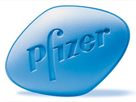Viagra F.A.Q.
Sildenafil.
Back in the late 1990s its active ingredient, Sildenafil, was tested as a cardiovascular drug. However, as it sometimes happens, it failed to meet the expectations of researches. Instead, Sildenafil revealed an interesting side effect that made it a revolutionary drug later on: the medication developed accidentally became the first oral ED drug greenlighted for use by the Food and Drug Administration in 1998. Since then it has turned into a primary solution to one of the major male sexual problems – erectile dysfunction.
Quick Facts about Viagra
• Viagra is a phosphodiesterase-5 inhibitor, which clinical trials have shown positive erectile results ranging between 60% and 80%. Together with other drugs belonging to this class it is being now widely prescribed to enhance the erectile response in men suffering from ED.
• Supplied as blue, film-coated pills of round-diamond shape Viagra is produced in three dosage forms and strengths: 25 mg, 50 mg and 100 mg. Each dosage form contains the respective amount of Sildenafil Citrate (citrate salt) equivalent to that of Sildenafil.
• Viagra pills increase the blood flow to the penile area. Upon taking these inhibit the action of the PDE5 enzyme (a major destroyer of the cGMP) and increase the levels of nitric oxide. Both the cGMP and nitric oxide are responsible for regulating the work of penile blood vessels.
• Due to the mechanism of action provided, namely muscle relaxation followed by blood supply increase, Viagra produces strong hypotensive effects of nitrates. Thus, its administration in patients taking organic nitrites or organic nitrates in any form is strictly contraindicated.
Dosage and Administration.
Although Viagra is produced in three dosage forms ranging from the lowest 25 mg to the highest 100 mg, a typical dosage recommendation starts with 50 mg. Depending on overall toleration, effectiveness and individual response of each patient treated the dose can be either decreased to the minimum or increased to the maximum. No adjustment is allowed without doctor's preapproval. The dose individualized should be taken orally with or without food, approximately an hour before an expected sexual activity. This way the medication will be able to produce the maximum effect. On the whole, the med can be taken between 30 minutes and 4 hours before an expected sexual activity. The maximum dosing frequency strongly recommended to all patients is once per day.
Major and Minor Interactions.
Around 458 drugs have been reported to interact with Viagra, where 41 have been marked as major (not recommended as the risk outweighs the benefit), 408 as moderate (recommended only under special circumstances), and 9 as minor (the risk is minimized, though requires caution). Additionally, there are five disease interactions with Viagra and two alcohol and food ones:
1. Simultaneous administration of the medication with nitric oxide donors is contraindicated. Co-administering Viagra with alpha-blockers (e.g. Doxazosin and Prazosin), CYP3A4 inhibitors (e.g. Ritonavir, Ketoconazole and Erythromycin) and calcium channel blockers (e.g. Amlodipine) should be done with due caution.
2. Cardiovascular disease, liver disease, renal failure, priapism (a prolonged erection) and retinitis pigmentosa are five major conditions that require the strictest monitoring when being on Viagra therapy. Here both dosage and duration will be strongly individualized and used unless the risk outweighs the benefits.
3. Although interactions of Viagra with alcohol and grapefruit products are marked as moderate, consumption of both should be either avoided or limited. While the combination of Viagra with ethanol can increase a blood pressure lowering effect, grapefruit products can raise the levels of the drug in your body.
List of Possible Side Effects.
Together with the needed effects Viagra may cause some unwanted ones. Any adverse reaction occurring during the therapy requires thorough medical attention. All side effects are usually classified as more common, less common and rare. Likewise, these can be distributed according to their respective medical fields; such classification, however, is of more interest to healthcare professionals. Thus, patients on Viagra therapy should be aware of the following reactions:
1. Side effects requiring immediate consultation of a health care provider:
• Less common: burning, crawling, numbness, prickling, itching or tingling feelings, dizziness, burning chest pain, burning feeling or tenderness in the stomach area, indigestion, stomach upset, increased frequency of urination, cloudy or bloody urine, bladder pain, pain on urination.
• Rare: anxiety or confusion, blurred vision or bleeding of the eye, chills or cold sweats, hearing loss, drowsiness, convulsions (seizures), fainting, sudden or unusual weakness, shakiness, trouble breathing, prolonged and/or painful erection, painful, swollen joints, etc.
2. Side effects that may not need any special medical attention, since those appear when the body gets used to the medication:
• More common: headache, stomach discomfort following meals, diarrhea, flushing, redness of the skin, unusually warm skin, bloody, stuffy or runny nose, sneezing, trouble sleeping, tenderness or pain around the cheekbones and eyes, etc.
• Rare: severe or continuing diarrhea or stomach cramps, nausea, vomiting, difficulty swallowing, ear pain, increased skin sensitivity, sleepiness, lack of coordination, tense muscles, loss of bladder control, redness or irritation of the tongue, etc.
The mentioned reactions may appear but not necessarily. A health care provider fully informed about patient's medical history and currently taken medications will be able to prevent or reduce any of these. Nevertheless, the patient must strictly follow all the recommendations given.

